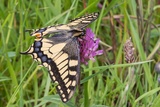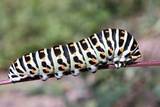Papilio machaon Linnaeus, 1758 Species
Last modified: Nov. 10, 2025, 3:08 p.m.
A fairly common species throughout Belgium. Numbers can vary between years but the species is never rare.
Details
- Classification
- Family: Papilionidae > Subfamily: Papilioninae > Tribus: Papilionini > Genus: Papilio > Species: Papilio machaon
- Vernacular names
- Koninginnenpage (NL), The Swallowtail (EN), Machaon (FR), Schwalbenschwanz (DE)
- First mention in Belgium
- De Sélys-Longchamps E. 1837. Catalogue des Lépidoptères ou Papillons de la Belgique, précédé du tableau des Libellulines de ce pays. — — : 1–29. On page 15 (as Papilio machaon). view page
- Status
-
Native
Distribution
Imago
Wing length 32–41mm. This large species is easily identified by its unique black pattern on a pale yellowish ground colour. Apart from the blackish accentuated veins, the wings have a dark base and a dark subterminal band. On the hindwing, this subterminal band has a series of blue spots with a red eyespot in the tornus.
Caterpillar
Young larvae are blackish with several small spines per segment and a white dorsal patch, making them look like a small bird dropping. In later instars the caterpillars lose their spines and their camouflage when they get a green ground color with each segment wearing a black transverse band with red spots.
Bionomics
A thorough description of the bionomics of this species can be found on the Butterflies in the Benelux website.
Flight periods
The adults fly in two generations a year from late April till the end of June, and from early July till the end of August with singletons flying into autumn.
Observed on
- Host plant (species):
- Peucedanum palustre, Angelica sylvestris and Daucus carota
The larva lives on several species of Umbelliferae, commonly on Daucus carota and Foeniculum vulgare. Eggs are often laid on small plants on bare ground. Caterpillars are commonly found in gardens.
Habitat
This is a widespread species in Belgium, especially to be found on warmer grasslands. Not only natural (calcareous) grasslands but also along south-facing dikes and roadsides, on former slag heaps, in gardens,... Males can be found hill-topping.











